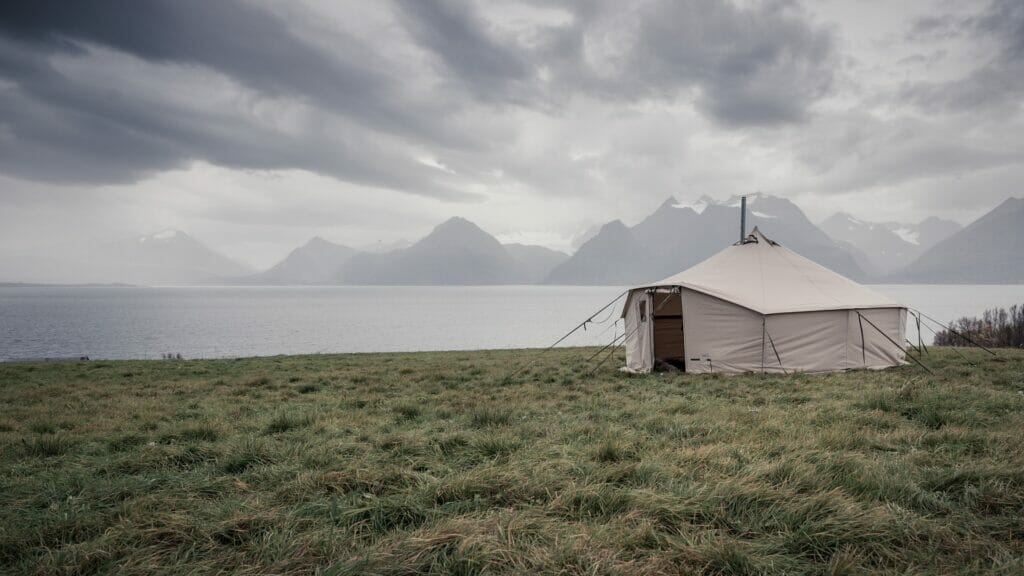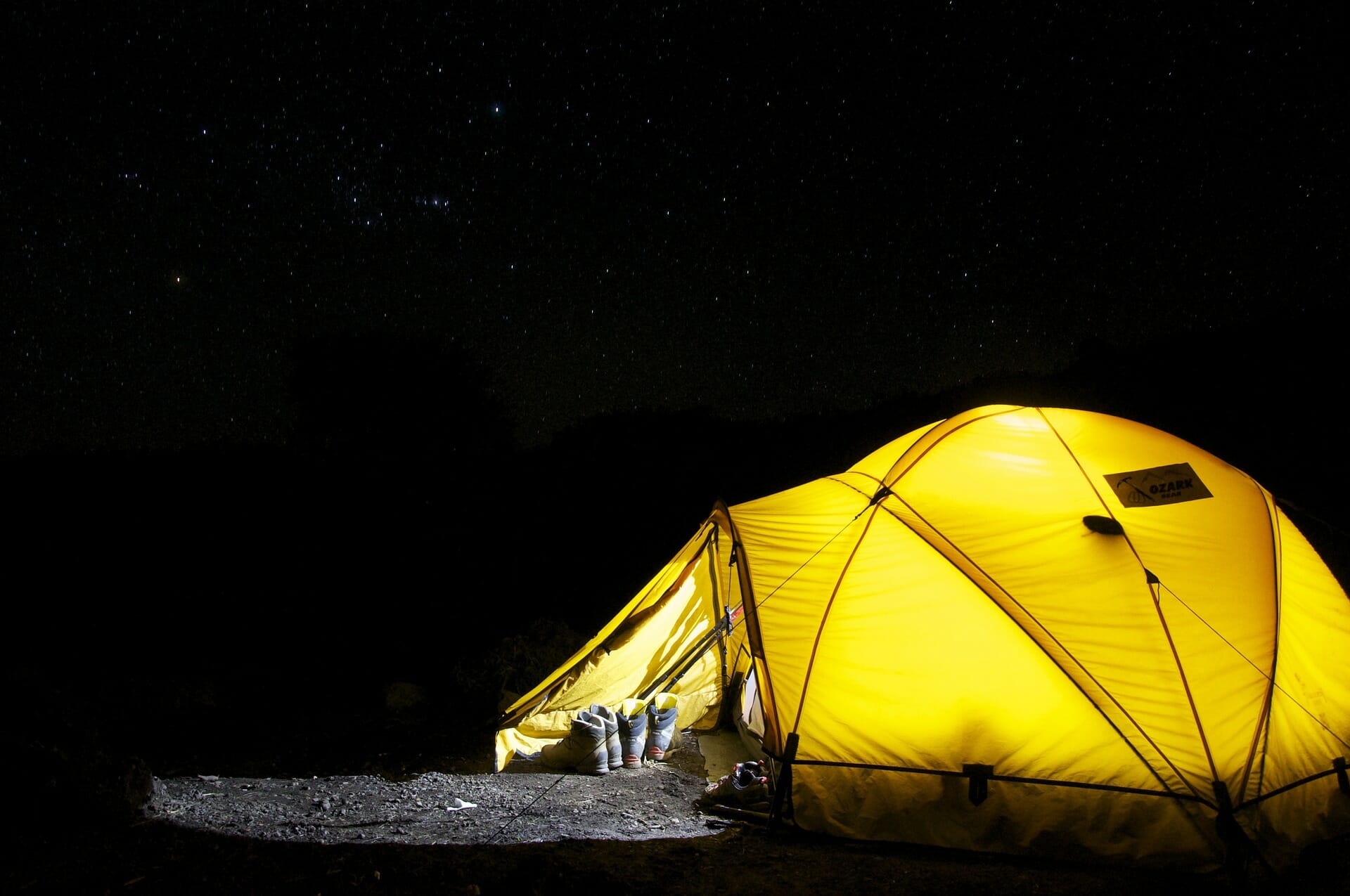Last Updated on January 10, 2023 by Mosabbir
Most people have heard of tents but don’t know much about them. What are tents made of? What are the different types of fabrics used in tent construction? This article will explore these questions and provide a guide to the different types of tent fabrics available on the market today.
Whether you are looking for a new tent for your next camping trip or hoping to replace an old one, this article will give you the information you need to make an informed decision.
In What Materials Are Tents Made?
Which materials you should choose depends on their intended use. For example, a tent designed for backpacking will be made from different materials than one designed for car camping.
The weight and durability of the fabric are important considerations when choosing a tent.
- Polyester
- Nylon
- Cotton or Canvas
- Poly-cotton Tents
- Cuben Fiber (DCF)
Learn More: What Electrics Do I Need For My Campervan?

Polyester
Polyester is a synthetic fabric that is often used in combination with other materials such as nylon. It is lightweight and durable, making it a good choice for backpacking tents.
Polyester is also waterproof and quick-drying, so it’s ideal for use in rainy or humid conditions. However, polyester can be less breathable than other materials, so it may not be as comfortable in hot weather.
| Pros: | Cons: |
|
|
Nylon
Nylon is another synthetic fabric that is often used in tents. It is strong and lightweight, making it a good choice for backpacking tents.
Nylon is also waterproof and quick-drying, but like polyester, it can be less breathable in hot weather. Nylon is usually less expensive than polyester, so it’s a good choice if you’re on a budget.
| Pros: | Cons |
|
|
Cotton or Canvas
Cotton or canvas tents are usually heavier than tents made from synthetic materials. However, they are more breathable, so they may be more comfortable in hot weather.
Cotton or canvas tents are also less likely to tear or puncture than synthetic tents. But because they are not waterproof, they are not ideal for use in rainy or humid conditions.
| Pros: | Cons: |
|
|
Poly-cotton Tents
Poly-cotton tents are made from a blend of polyester and cotton fibres. They are usually more breathable than pure polyester tents, but not as much as pure cotton tents.
Poly-cotton tents are also more durable than pure polyester tents, but not as much as pure cotton tents. However, because they are made from natural fibres, they are not as waterproof as synthetic tents.
| Pros: | Cons: |
|
|
Cuben Fiber (DCF)
Cuben fibre (DCF) is a high-tech synthetic material that is often used in ultralight backpacking tents. It is very strong and lightweight, making it ideal for backpacking.
It is also waterproof and has excellent moisture resistance. However, it can be expensive and is not as widely available as other materials.
| Pros: | Cons: |
|
|
Learn More: How To Dry Wet Clothes When Camping

What Are The Different Types Of Tents?
There are four main types of tents available on the market: dome tents, cabin tents, pop-up tents, and screen houses. Let’s take a closer look at each one.
Dome Tents: Dome tents are perhaps the most popular type of tent available. They get their name from their geodesic shape which makes them incredibly sturdy in high winds.
Dome tents are also relatively easy to set up and take down which makes them a great option for first-time campers or those who don’t want to spend a lot of time setting up their campsite. However, dome tents can be on the more expensive side and they don’t have a lot of headroom which can make them feel cramped.
Cabin Tents: Cabin tents are another popular option among campers. They get their name from their cabin-like shape which offers more headroom than other types of tents.
Cabin tents are also usually better equipped to handle inclement weather than other types of tents, thanks to their sturdier construction. However, cabin tents can be more difficult to set up than other types and they often don’t have as much ventilation, which can make them hot in warm weather.
Pop-Up Tents: Pop-up tents are a great option for those who want an easy set-up process. As the name implies, these tents “pop up” into place thanks to their pre-assembled poles.
All you have to do is unpack the tent and stake it down. Pop-up tents are usually less expensive than other types of tents but they aren’t as durable and they often don’t have as much headroom.
Screen Houses: Screen houses are a good option for those who want protection from bugs but don’t necessarily need a full-fledged tent. Screen houses are typically less expensive than other types of tents and they offer good ventilation thanks to their screen walls.
However, screen houses don’t offer much protection from the elements and they can be difficult to set up if you don’t have help.
Learn More: The Benefits of Having a Microwave in a Caravan
What Material Is The Tent Pole Made Of?
Aluminium Tent Poles
Aluminium tent poles are by far the most popular type of tent pole. They’re lightweight, strong, and easy to set up. Plus, they’re relatively inexpensive, which makes them a great option for budget-minded campers.
However, aluminium tent poles are not without their drawbacks. One major downside is that they’re not as durable as some of the other options on this list. They can also be difficult to repair if they break while you’re on a camping trip.
Fiberglass Tent Poles
Fibreglass tent poles are another popular option for campers. They offer many of the same benefits as aluminium tent poles, but they’re even lighter. Fibreglass poles are also more flexible than aluminium, which means they’re less likely to break in high winds.
However, fibreglass tent poles are more expensive than their aluminium counterparts and can be difficult to repair if they break.
Carbon Fiber Tent Poles
If you’re looking for the lightest weight possible, carbon fibre tent poles are the way to go. Carbon fibre is also very strong, making it a good choice for tents that will be exposed to high winds or heavy snow loads.
However, carbon fibre tent poles are also very expensive—often twice as much as fibreglass or aluminium—and can be difficult to repair if they break.
Steel Tent Poles
Steel tent poles are one of the heaviest options on this list, but they offer superior strength and durability. Steel is also much less likely to bend or break in high winds than either aluminium or fibreglass.
However, steel’s increased weight can make it more difficult to set up your tent, and steel tent poles are more expensive than their aluminium or fibreglass counterparts.
Air Beams
Air beams are a relatively new innovation in the world of tents and camping gear. Air beams are inflatable tubes that replace traditional rigid pole structures.
Air beams have many advantages over traditional rigid pole structures they’re lighter, easier to set up, and more resistant to wind damage. But they’re also more expensive and can be punctured if not used properly.
Conclusion
There are a variety of different types of tent poles available on the market, each with its own set of advantages and disadvantages. When choosing a tent pole, it’s important to consider your needs and priorities. If weight is your primary concern, carbon fibre or composite materials are a good choice.
If you’re looking for maximum strength and durability, steel is a good option. And if you’re on a budget, aluminium or fibreglass are both good choices. Whichever type of tent pole you choose, make sure you’re familiar with the setup process and have all the necessary tools and supplies before heading out on your camping trip.
